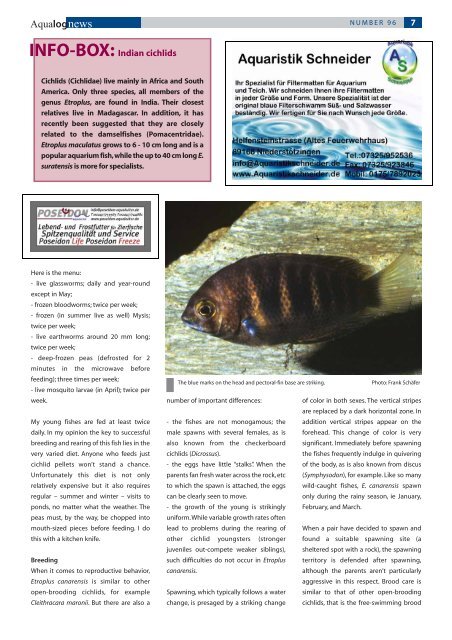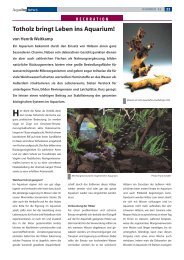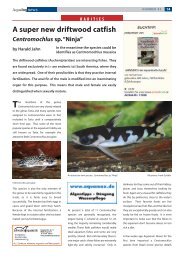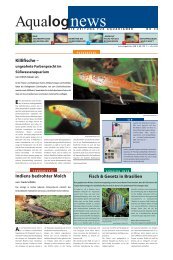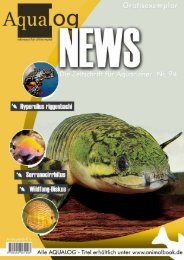Moenkhausia cosmops - Aqualog
Moenkhausia cosmops - Aqualog
Moenkhausia cosmops - Aqualog
Create successful ePaper yourself
Turn your PDF publications into a flip-book with our unique Google optimized e-Paper software.
<strong>Aqualog</strong>news NUMBER 96 7<br />
INFO-BOX: Indian cichlids<br />
Cichlids (Cichlidae) live mainly in Africa and South<br />
America. Only three species, all members of the<br />
genus Etroplus, are found in India. Their closest<br />
relatives live in Madagascar. In addition, it has<br />
recently been suggested that they are closely<br />
related to the damselfishes (Pomacentridae).<br />
Etroplus maculatus grows to 6 - 10 cm long and is a<br />
popular aquarium fish,while the up to 40 cm long E.<br />
suratensis is more for specialists.<br />
Here is the menu:<br />
- live glassworms; daily and year-round<br />
except in May;<br />
- frozen bloodworms; twice per week;<br />
- frozen (in summer live as well) Mysis;<br />
twice per week;<br />
- live earthworms around 20 mm long;<br />
twice per week;<br />
- deep-frozen peas (defrosted for 2<br />
minutes in the microwave before<br />
feeding); three times per week;<br />
- live mosquito larvae (in April); twice per<br />
week.<br />
My young fishes are fed at least twice<br />
daily. In my opinion the key to successful<br />
breeding and rearing of this fish lies in the<br />
very varied diet. Anyone who feeds just<br />
cichlid pellets won’t stand a chance.<br />
Unfortunately this diet is not only<br />
relatively expensive but it also requires<br />
regular – summer and winter – visits to<br />
ponds, no matter what the weather. The<br />
peas must, by the way, be chopped into<br />
mouth-sized pieces before feeding. I do<br />
this with a kitchen knife.<br />
Breeding<br />
When it comes to reproductive behavior,<br />
Etroplus canarensis is similar to other<br />
open-brooding cichlids, for example<br />
Cleithracara maronii. But there are also a<br />
The blue marks on the head and pectoral-fin base are striking. Photo: Frank Schäfer<br />
number of important differences:<br />
- the fishes are not monogamous; the<br />
male spawns with several females, as is<br />
also known from the checkerboard<br />
cichlids (Dicrossus).<br />
- the eggs have little “stalks”. When the<br />
parents fan fresh water across the rock, etc<br />
to which the spawn is attached, the eggs<br />
can be clearly seen to move.<br />
- the growth of the young is strikingly<br />
uniform.While variable growth rates often<br />
lead to problems during the rearing of<br />
other cichlid youngsters (stronger<br />
juveniles out-compete weaker siblings),<br />
such difficulties do not occur in Etroplus<br />
canarensis.<br />
Spawning, which typically follows a water<br />
change, is presaged by a striking change<br />
of color in both sexes. The vertical stripes<br />
are replaced by a dark horizontal zone. In<br />
addition vertical stripes appear on the<br />
forehead. This change of color is very<br />
significant. Immediately before spawning<br />
the fishes frequently indulge in quivering<br />
of the body, as is also known from discus<br />
(Symphysodon), for example. Like so many<br />
wild-caught fishes, E. canarensis spawn<br />
only during the rainy season, ie January,<br />
February, and March.<br />
When a pair have decided to spawn and<br />
found a suitable spawning site (a<br />
sheltered spot with a rock), the spawning<br />
territory is defended after spawning,<br />
although the parents aren’t particularly<br />
aggressive in this respect. Brood care is<br />
similar to that of other open-brooding<br />
cichlids, that is the free-swimming brood


